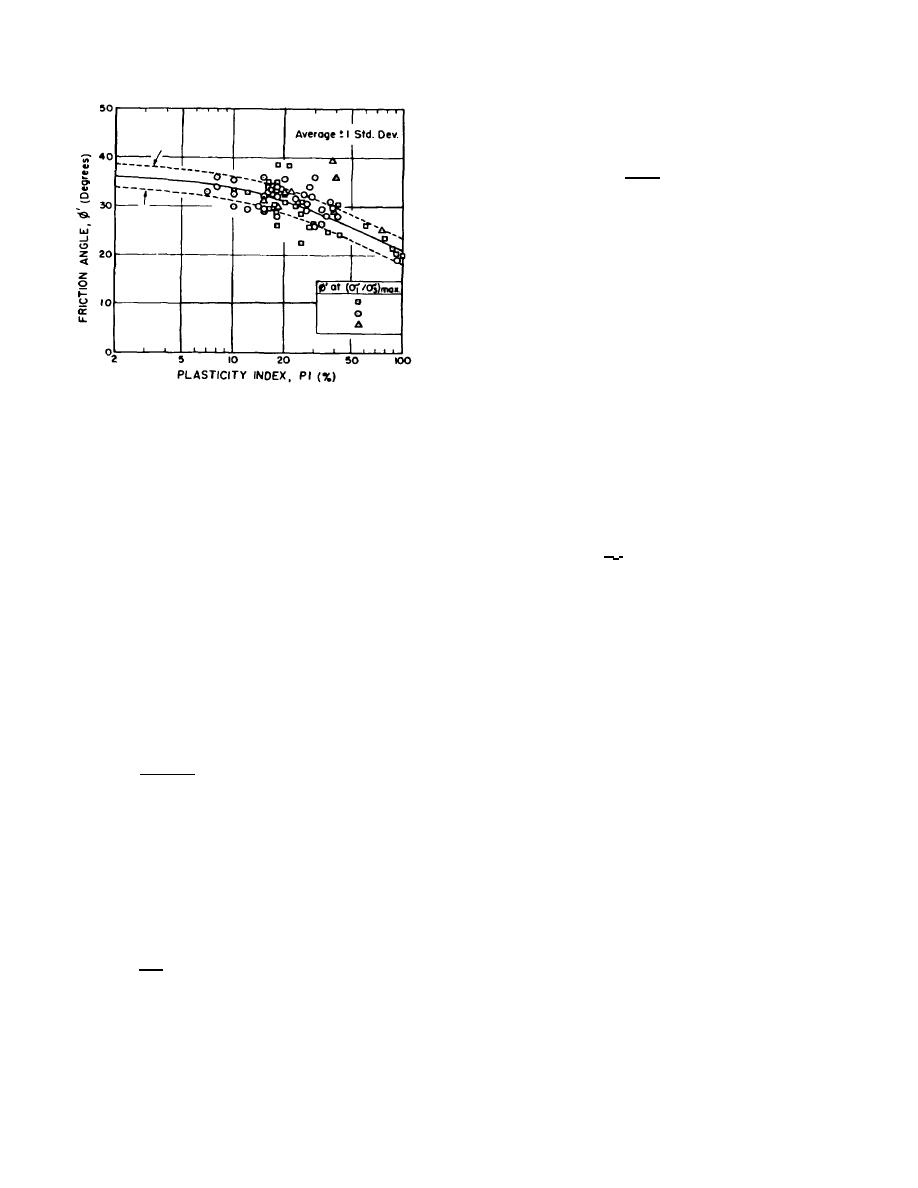
TM 5-818-1 / AFM 88-3, Chap. 7
be as low as 0.1 to 0.2 at small strains, or more than 0.5.
3-9.
Modulus of subgrade reaction.
a. The modulus of subgrade reaction, ks, is
the ratio of load intensity to subgrade deformation, or:
ks =
q
(3-18)
∆
where
q = intensity of soil pressure, pounds or
kips per square foot
∆ = corresponding average settlement,
feet
b. Values of k. may be obtained from general
order of decreasing accuracy:
(1) Plate or pile load test (chaps 4 and 12).
(2) Empirical equations (additional discussion
in chap 10).
(3) Tabulated values (table 3-6).
U. S. Army Corps of Engineers
3-10. Coefficient of at-rest earth pressure. The
state of effective lateral stress in situ under at-rest
Figure 3-18. Empirical correlation between friction angle
conditions can be expressed through the coefficient of
and plasticity index from triaxial compression tests on
earth pressure at rest and the existing vertical
normally consolidated undisturbed clays.
overburden pressure. This ratio is termed Ko and given
by the following:
Elastic properties (E, ). The elastic modulus
3-8.
and Poisson's ratio are often used in connection with the
σh'
=
(3-19)
Ko
elasticity theory for estimating subsoil deformations.
σv'
Both of these elastic properties vary nonlinearly with
The coefficient of at-rest earth pressure applies for a
confining pressure and shear stress. Typical values
condition of no lateral strain. Estimate values of K0 as
given below refer to moderate confining pressures and
follows:
shear stresses corresponding to a factor of safety of 2 or
more.
Normally consolidated soil
a. In practical problems,
stresses before
Sand:
loading are generally anisotropic.
It is generally
K0 = 1 - sin φ`
(3-20)
considered that the modulus of elasticity is proportional
Clay:
to the square root of the average initial principal stress,
K0 = 0.95 - sin φ'
(3-21)
which may usually be taken as
Figure 3-21 may be used for estimates of K0 for both
normally consolidated and overconsolidated soils in
)
(
σv'
1/2
1 + 2K0
(3-16)
terms of PI. For overconsolidated soils, this figure
3
applies mainly for unloading conditions, and reloading
may cause a large drop in K0 values. For soils that
where K0 is the coefficient of at-rest earth pressure (para
display high overconsolidation ratios as a result of
3-10) and δv' is the effective vertical stress. This
desiccation, K0 will be overestimated by the relationship
proportionality holds for 0.5 < K0 < 2, when working
shown in figure 3-21.
stresses are less than one-half the peak strength.
b. The undrained modulus for normally
3-11. Properties of intact rock. The modulus ratio
consolidated clays may be related to the undrained shear
and uniaxial compressive strength of various intact rocks
strength, su, by the expression
are shown in table 2 -7.
E
= 250 to 500
(3-17)
3-12. Properties of typical shales.
Behavioral
su
characteristics of shales are summarized in table 3-7;
where su is determined from Q tests or field vane shear
and physical properties of various shales, in table 3-8.
tests. The undrained modulus may also be estimated
Analyses of observed in situ behavior provide the most
from figure 3-20. Field moduli may be double these
reliable means for assessing and predicting the behavior
values.
of shales.
c. Poisson's ratio varies with strain and may
3-22


 Previous Page
Previous Page
